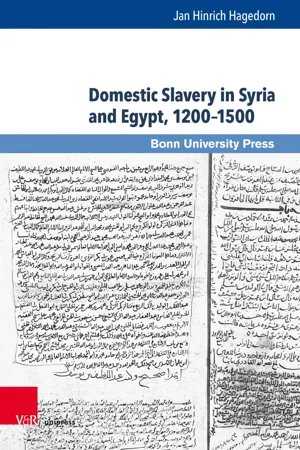
- 245 pages
- English
- PDF
- Available on iOS & Android
Domestic Slavery in Syria and Egypt, 1200–1500
About this book
Slavery touched many aspects of Mamluk society. This volume focuses on the role of slaves within the family, from birth to purchase, liberation, and death. It investigates domestic slavery in Syrian and Egyptian society from the thirteenth to the fifteenth century. Jan Hagedorn focuses on the agency of slaves in the context of master-slave relationships within households and in wider society. He argues that the ability of slaves to shape the world around them was underpinned by a constant process of negotiation within the master-slave relationship and that intermediaries such as the court system channelled the agency of slaves. The principal sources for this study are purchase contracts, listening certificates, marriage contracts, and estate inventories in combination with scribal, market inspection, and slave purchase manuals as well as chronicles.
Frequently asked questions
- Essential is ideal for learners and professionals who enjoy exploring a wide range of subjects. Access the Essential Library with 800,000+ trusted titles and best-sellers across business, personal growth, and the humanities. Includes unlimited reading time and Standard Read Aloud voice.
- Complete: Perfect for advanced learners and researchers needing full, unrestricted access. Unlock 1.4M+ books across hundreds of subjects, including academic and specialized titles. The Complete Plan also includes advanced features like Premium Read Aloud and Research Assistant.
Please note we cannot support devices running on iOS 13 and Android 7 or earlier. Learn more about using the app.
Information
Table of contents
- Title Page
- Copyright
- Table of Contents
- Body
- Acknowledgements
- Introduction
- 1. The Urban Slave Market
- 2. The Practice of Selling Slaves
- 3. Integration and Participation
- 4. Sexual Exploitation and Accommodation
- 5. Manumission
- 6. Independence and Death
- Conclusions
- Bibliography
- Appendix 1: Key Documents
- Appendix 2: Tables
- Index